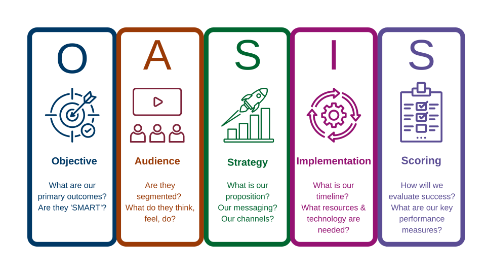The OASIS framework
OASIS is a series of steps that can help bring order and clarity to planning communications. The aim is to make the process rigorous and consistent. OASIS is a best practice framework championed by the UK government and used extensively across the public sector. We use the OASIS framework to inform our Transformation Communications & Engagement Process.
The 5 elements of OASIS are:
- Objectives
- Audience/Insight
- Strategy/Ideas
- Implementation
- Scoring/Evaluation

Find out more about the OASIS framework
Getting started: Our Transformation Communications and Engagement Process
About our process
We’ve created a helpful video that gives an overview, but we’ve provided more detail below.

Brief
At the briefing stage we encourage strong dialogue between the project and comms lead. Some of the activity involved includes:
- The comms lead should be notified of the potential need for support
- A briefing meeting between comms and the project
- The completion and submission of the communication brief
- The provision of any relevant documentation
The Communication Brief has been structured to encourage you to think through some important aspects of the requirements, including the description of your audiences, and what you want them to think, feel and do as a result of the communication. It is also vital to consider your timescales as some communications channels and assets take some time to develop, test and build.
The Project Lead is responsible for the Brief stage, and should ensure that the brief is approved by both their stakeholders and the Communications Lead.
Strategy
Following an approved brief, the Communications Lead is responsible for developing the appropriate strategic approach. Within this development phase are the following activities:
- Development of overall approach and concept
- The high-level messaging for the activity
- The selection of the most appropriate channels
- Confirmation of brand assets and tone of voice
- An outline schedule which will detail the key dates for deployment
This information may be gathered together in a Communications and Engagement Plan, which may be shared with stakeholders for review and approval.
Produce
Depending on the approach, there may be a significant amount of work in producing the assets or organising events for the communications and engagement campaign. Activities in ‘produce’ include:
- Development of full copy
- Development of creative assets such as infographics
- Print production for elements such as posters
- Video production and editing
- Website content design and build
- Email building and distribution list creation
- Event logistics
- Identification of performance criteria
The Communications Lead is responsible for these activities, however it is important to know that some of these activities are complex and may take longer than expected. This is particularly true of areas such as video production. The Project and Communications Leads should work closely to understand the impact of this and any dependencies that may arise.
Live
Once all the production elements are approved, the campaign is ready to ‘go live’. Activities may include:
- Asset deployment across channels, including email broadcast
- Project updates on progression of campaign activity
- Response handling
- Mid-flight adjustments
It’s important that the close collaboration continues through this Live period, to ensure that issues raised are dealt with quickly.
Measure
A Communications and Engagement campaign is only as good as its impact, so it is important that performance data is monitored in order that adjustments can be made or issues brought into project consideration. Activities will include:
- Reporting of hard measures (for example email open rates)
- Follow-up surveys to identify areas such as awareness or sentiment
- Organisation of retrospectives
The Project Lead is responsible for the collation and reporting of success measures.

